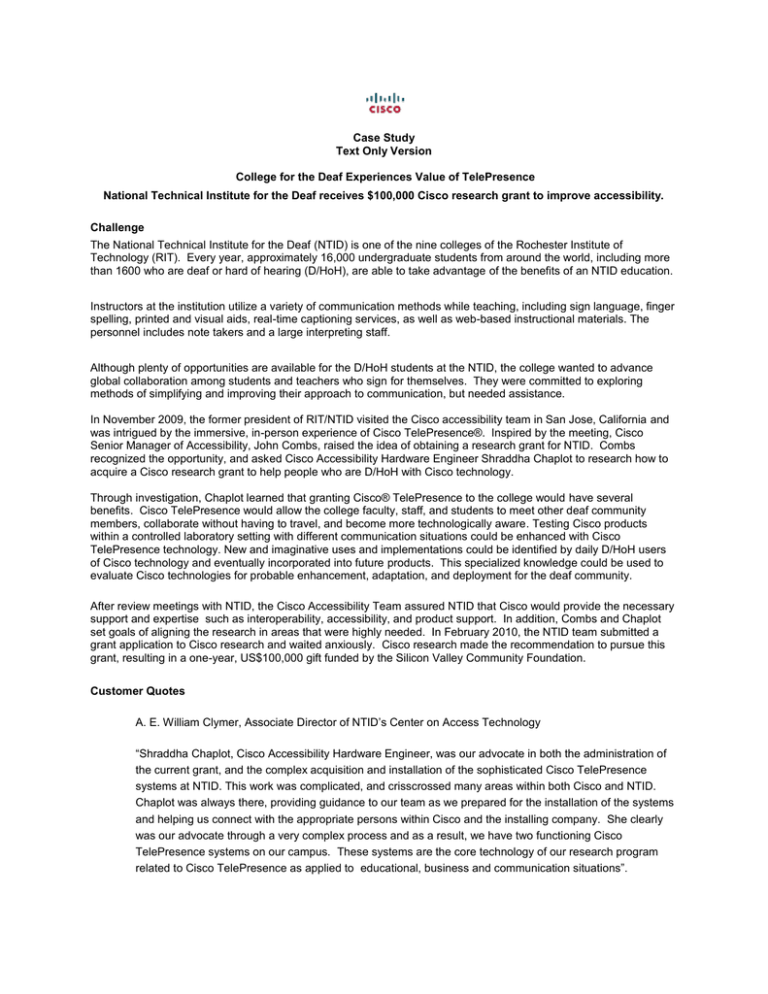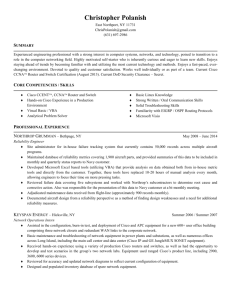
Case Study
Text Only Version
College for the Deaf Experiences Value of TelePresence
National Technical Institute for the Deaf receives $100,000 Cisco research grant to improve accessibility.
Challenge
The National Technical Institute for the Deaf (NTID) is one of the nine colleges of the Rochester Institute of
Technology (RIT). Every year, approximately 16,000 undergraduate students from around the world, including more
than 1600 who are deaf or hard of hearing (D/HoH), are able to take advantage of the benefits of an NTID education.
Instructors at the institution utilize a variety of communication methods while teaching, including sign language, finger
spelling, printed and visual aids, real-time captioning services, as well as web-based instructional materials. The
personnel includes note takers and a large interpreting staff.
Although plenty of opportunities are available for the D/HoH students at the NTID, the college wanted to advance
global collaboration among students and teachers who sign for themselves. They were committed to exploring
methods of simplifying and improving their approach to communication, but needed assistance.
In November 2009, the former president of RIT/NTID visited the Cisco accessibility team in San Jose, California and
was intrigued by the immersive, in-person experience of Cisco TelePresence®. Inspired by the meeting, Cisco
Senior Manager of Accessibility, John Combs, raised the idea of obtaining a research grant for NTID. Combs
recognized the opportunity, and asked Cisco Accessibility Hardware Engineer Shraddha Chaplot to research how to
acquire a Cisco research grant to help people who are D/HoH with Cisco technology.
Through investigation, Chaplot learned that granting Cisco® TelePresence to the college would have several
benefits. Cisco TelePresence would allow the college faculty, staff, and students to meet other deaf community
members, collaborate without having to travel, and become more technologically aware. Testing Cisco products
within a controlled laboratory setting with different communication situations could be enhanced with Cisco
TelePresence technology. New and imaginative uses and implementations could be identified by daily D/HoH users
of Cisco technology and eventually incorporated into future products. This specialized knowledge could be used to
evaluate Cisco technologies for probable enhancement, adaptation, and deployment for the deaf community.
After review meetings with NTID, the Cisco Accessibility Team assured NTID that Cisco would provide the necessary
support and expertise such as interoperability, accessibility, and product support. In addition, Combs and Chaplot
set goals of aligning the research in areas that were highly needed. In February 2010, the NTID team submitted a
grant application to Cisco research and waited anxiously. Cisco research made the recommendation to pursue this
grant, resulting in a one-year, US$100,000 gift funded by the Silicon Valley Community Foundation.
Customer Quotes
A. E. William Clymer, Associate Director of NTID’s Center on Access Technology
“Shraddha Chaplot, Cisco Accessibility Hardware Engineer, was our advocate in both the administration of
the current grant, and the complex acquisition and installation of the sophisticated Cisco TelePresence
systems at NTID. This work was complicated, and crisscrossed many areas within both Cisco and NTID.
Chaplot was always there, providing guidance to our team as we prepared for the installation of the systems
and helping us connect with the appropriate persons within Cisco and the installing company. She clearly
was our advocate through a very complex process and as a result, we have two functioning Cisco
TelePresence systems on our campus. These systems are the core technology of our research program
related to Cisco TelePresence as applied to educational, business and communication situations”.
B. E. William Clymer, Associate Director of NTID’s Center on Access Technology
“The quality of this technology is a quantum leap ahead of any other conferencing capability out there,” says
E. William Clymer, associate director of NTID’s Center on Access Technology.
Solution
In a multistrand effort, NTID agreed to provide a team of specialists who would help with research and conduct
preliminary investigations in the areas of 911 emergency calls, avatars, and Cisco TelePresence. The first strand
explores ways to use smartphones and Internet technology to permit a person who is deaf to make a 911 emergency
call. The second strand involves designing a signing avatar system. Avatars, virtual representations of people, can
potentially be utilized in educational settings or workplaces to offer a bridge between visual and spoken language.
The third strand targets Cisco TelePresence, the premium face-to-face conferencing experience over the network.
NTID agreed to research ways to extend these capabilities so that Cisco TelePresence could potentially also respond
to visual communications such as American Sign Language (ASL) and be utilized in their classroom setting. NTID’s
findings across these three areas will be essential in identifying new ways to improve technology for individuals who
are D/HoH.
Originally, Cisco and NTID agreed to deploy a single Cisco TelePresence System 500. After discussing this in greater
depth with sales engineers, the team decided to install a single screen with the Cisco TelePresence System 1300
and three 65-inch plasma screens with the Cisco TelePresence System 3210. With the ability to host up to 18
participants in a dedicated room, the Cisco TelePresence System 3210 would be ideal for NTID’s large team
meetings, cross-functional or training events, and distance learning. During the actual installation phase, Chaplot
worked with third-party installers to build a customized 14-seat room to fit the room better and to help ensure room for
wheelchair access.
Results
NTID is now able to have real-time video conferencing with people around the globe. The value of the TelePresence
Center grant from Cisco is approximately US$700,000. Recently, two NTID computing and information students
(Samuel Sandoval, of Fairfax, Virginia, and Kelley Duran, of North Fayston, Vermont) completed co-ops with Cisco.
Sandoval and Duran completed projects demonstrating how to integrate Realtime Text (RTT) into a product, such as
the Cisco Cius™ Android tablet, and Closed Captioning integration solutions for Cisco TelePresence. They scoped
ways to caption Cisco TelePresence video conferences to allow persons with hearing disabilities, or those operating
in a second language, to read conversations in real-time during a video conference. Through this cooperative
education experience, these product engineering teams came to the self-realization that the world not only needs a
greater awareness of accessibility, but that all products should be accessible to all employees, consumers, and
customers.
Next Steps
Cisco’s partnership with leading institutions, such as RIT/NTID, combines research excellence with technological
innovation. For NTID, Cisco TelePresence is making a difference in faculty, staff, and student communication. This
and the other two strands of research are expected to continue at RIT/NTID through 2012, when the college will
present findings to Cisco research. Support for this research is part of the Cisco commitment to bring the power of the
network everywhere; transforming the way the world communicates and collaborates.
For More Information
-
To follow the progress of the grant, visit NTID's website: http://www.rit.edu/ntid/cat/cisco/.
-
Watch a video the Cisco team created regarding this effort:
http://www.youtube.com/watch?v=Wj9OzEN50vw.
-
For more information on Accessibility at Cisco, please go to: http://www.cisco.com/go/accessibility/ or email
us at accessibility@cisco.com.
Addresses and contact information, copyright notice, legal disclaimers
Americas Headquarters
Cisco Systems, Inc.
San Jose, CA
Asia Pacific Headquarters
Cisco Systems (USA) Pte.Ltd.
Singapore
Europe Headquarters
Cisco Systems International BV Amsterdam,
The Netherlands
Cisco has more than 200 offices worldwide. Addresses, phone numbers, and fax numbers are listed on the
Cisco Website at www.cisco.com/go/offices.
Cisco and the Cisco logo are trademarks or registered trademarks of Cisco and/or its affiliates in the U.S. and
other counties. To view a list of Cisco trademarks, go to this URL: www.cisco.com/go/trademarks. Third party
trademarks mentioned are the property of their respective owners. The use of the word partner does not imply a
partnership relationship between Cisco and any other company. (1110R)
© 2012 Cisco and/or its affiliates. All rights reserved. This document is Cisco Public.




